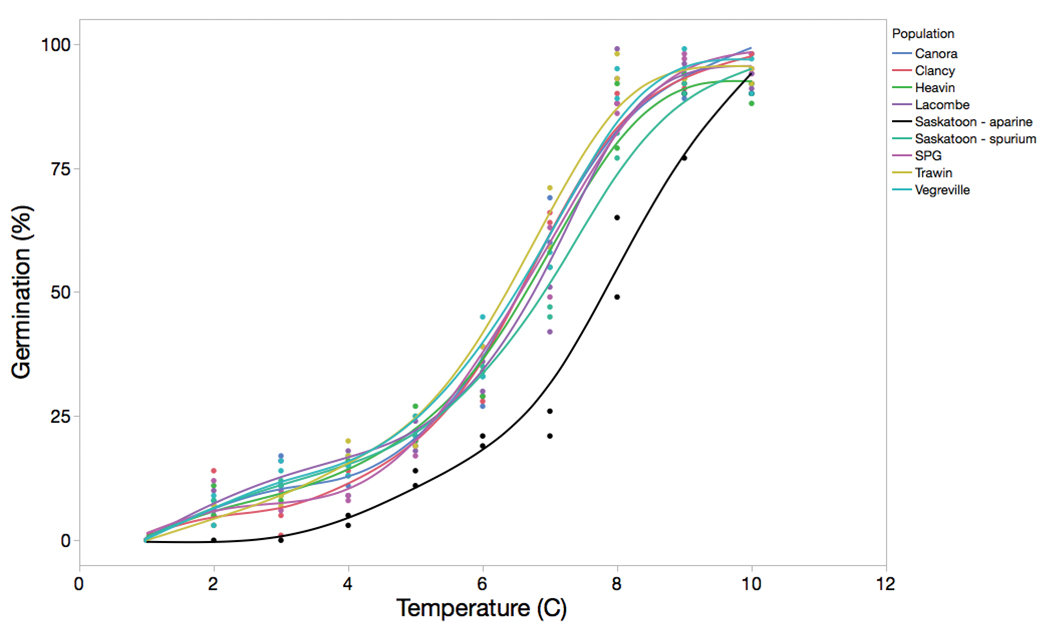Use pre-seed burnoff and pre-harvest herbicide for cleavers control
KEY RESULT:
Cleavers can germinate very early in the spring, making pre-seed burnoff a good way to control the weeds when they’re small and limit cleavers seed in harvested canola. Pre-harvest saflufenacil plus glyphosate may also provide short- and long-term management.
PROJECT TITLE, PRINCIPAL INVESTIGATOR:
“Assessing the influence of base germination temperature and chemical desiccants on the recruitment biology of cleavers,” Chris Willenborg, University of Saskatchewan
FUNDING:
SaskCanola
This study shows that cleavers populations in Western Canada have a base germination temperature of around 2°C. This is the temperature at which seeds will start to germinate. Willenborg and his team also found that 50 per cent of cleavers will germinate by around 6°C or 7°C, which means the weed can start growing within the first couple weeks of April, most years. This provides a good opportunity for farmers to control the weed with a pre-seed application of herbicide.
Galium aparine L. (cleavers or catchweed bedstraw) and Galium spurium L. (false cleavers) are problematic weed species in canola. A survey by AAFC’s Julia Leeson in 2016 ranked them 7th and 6th in abundance in all annual crops and canola, respectively. Cleavers reduce yield, increase crop lodging, interfere with harvest operations, and reduce canola grades through seed contamination. Seed contamination is an issue because both cleavers and canola are similar in size and shape, making them difficult to separate. In addition, about 20 per cent of cleavers surveyed in Saskatchewan have evolved resistance to Group-2 herbicides and research by Hugh Beckie considered cleavers a high-risk weed for evolved glyphosate resistance, which is why pre-seed and fall applications should include a tank mix with glyphosate.
The objective of this study was twofold: to determine the differences in base germination temperatures of Galium spp. populations from different locations in western Canada, and to investigate options for reducing cleavers seed return in canola crops.
The first experiment was conducted at Agriculture and Agri-Food Canada in Saskatoon, using eight Galium spurium populations collected from across Western Canada and one Galium aparine population from the Saskatoon area. The seeds were subjected to germination studies on a thermogradient plate that included a range of temperatures (1-10° C) set at 1°C increments. Base temperature for germination was a consistent 2°C for all Galium spurium populations and 4°C for the Galium aparine population.

The second experiment was a field study conducted at two sites (Saskatoon and Scott, Saskatchewan) in 2016 and 2017. This experiment evaluated the effect of pre-harvest herbicides on cleavers contamination in canola crops, as well as cleavers seed viability and vigour. Herbicides evaluated included saflufenacil, diquat, glufosinate, saflufenacil plus glyphosate, diquat plus glyphosate, and glufosinate plus glyphosate.
All pre-harvest applications were made when 60-75 per cent of the canola plants had changed colour from green to brown. (Note: This does not match the label-approved timing for each product.)
The percentage of cleavers found in the harvested sample for all treatments was < 2.0 per cent, and the only treatment to reduce cleavers contamination below 1.0 per cent was saflufenacil plus glyphosate. However, all pre-harvest treatments significantly lowered cleavers seed viability compared to the untreated check. This means a smaller viable seedbank for those cleavers seeds shed before combining.
Using pre-harvest herbicides is a production practice that can improve the harvestability of standing canola and can also reduce the viability of seeds for weeds that still have seeds at the time of application. Cleavers management may benefit from such an approach as it retains a high percentage of its seed until crop harvest .





